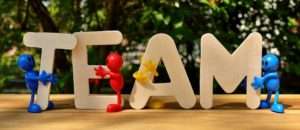How to Cultivate a Creative Corporate Culture

Many believe that corporate culture is all about dress code and employee attendance at common events. But this is too narrow a point of view. Of course, both uniforms and corporate events are part of the culture of the company and significantly affect its microclimate, but they do not exhaust all the richness of aspects of such a phenomenon as the internal corporate culture.
What is a corporate culture
Corporate culture is a set of social norms, rules and values shared by all employees and management. It can include many parallel “codes” of conduct for different categories of personnel. The corporate culture, along with financial motivation, serves as a carrot and a stick: on the one hand, it encourages fruitful work and career advancement, provides confidence in the future, on the other hand, it rigidly prevents the violation of established rules.
It is carried by everyone who works in the organisation: from top managers to an ordinary courier.
Important functions of the corporate culture
- Image: a well-developed, strong culture fosters a sustainable, positive image of the firm that attracts not only end customers but also job candidates.
- Motivational: the correct corporate culture is a source of inspiration for employees, makes them achieve high results and efficiently perform assigned tasks.
- Engaging: Helps to ensure that each team member is actively involved in the life of the company.
- Identifying: employees define themselves through belonging to the company, their self-esteem is built on this.
- Adaptive: promotes the rapid infusion of new employees into the team.
- Management: the creation of rules and regulations for the management of the organization, individual departments.
- System-forming: the activities of all departments are streamlined, systematised.
The marketing function is no less important: the philosophy and strategic goals of an enterprise determine its positioning in the market, and corporate values influence the style of interaction with customers, partners and other audiences.
Advantages and Disadvantages of Corporate Culture Development
Like any other phenomenon, corporate culture has its own characteristic disadvantages and advantages.
Advantages of Corporate Culture Development
Uniform principles and traditions in work are a guarantee of a certain level of product quality.
A close-knit team is easier to tolerate changes, more willing to rebuild.
All employees feel that they are an important and necessary part of a single organism.
Disadvantages of Corporate Culture Development
Negative attitude towards employees who do not share the norms of internal culture (already established or just emerging), sometimes even their dismissal.
It is difficult to hire highly qualified specialists: their values may not coincide with corporate ones.
The need for constant support and development of the enterprise culture, active steps in this direction, and not just propaganda (which, apart from real affairs, will only cause rejection among the staff).
Key Elements of Corporate Culture
Traditionally, the main elements of a company’s corporate culture include:
These are any objects, events and actions that are significant to others and reflect the key values of the enterprise culture. For example, Bill Arnold, president of the Centennial Medical Centre, an open door company, actually ordered the door to be removed from his office. And the president of MasterBrand Industries, Randall Larrymore, with a strong focus on teamwork, has removed the internal partitions between departments.
-
Legends
These are narratives about events in the company that have a real basis and are known to all staff. The legends represent stories that are constantly retold by employees and reflects (usually indirectly) the company’s core value.
People who embody the key features of corporate culture in their character, actions and exploits become heroes. The hero is a role model for everyone who works in the company. As a rule, these are fictional characters, but in some cases, they are quite real people. Heroes behave extraordinarily and achieve high results, but only those that can be repeated by ordinary employees. That is, the goal of a heroic character as an instrument of corporate culture is to embody the values of the company and unite people, to show how to do good deeds.
-
Mottos and Slogans
These are short phrases that succinctly formulate the main value of the company’s culture. For example, the motto of Sequins International, which employs 80% Hispanic workers, is “Don’t please your boss, please your customers” by W. Edwards Deming. This phrase (in Spanish translation) is applied to the pocket of each employee’s uniform jacket.
These are events of a special type, planned in advance and having no other goals than the development of corporate culture. During the ceremonies, employees are shown the most striking examples of the embodiment of corporate values, heroes are proclaimed. This gives employees a sense of involvement in an important event, strengthening of team spirit, strengthening of faith in the declared values.
In this way, the culture of an organization can be studied and interpreted from such visible incarnations as symbols, ceremonies, legends, heroes and slogans.
-
Activities
Corporate events, in which the entire staff of the company participates, contribute to the establishment of personal relationships, an acquaintance of employees with each other. The most popular types are celebrations of the anniversary of the company, trips to country picnics, joint trips to the theatres, etc.
The main types of the corporate culture
There are many different organizational cultures that take hold in corporations.
1. “Role model”
This is the strictest and most regulated type of internal culture of the enterprise, where each employee is a tiny cog in a huge system, debugged to the limit. There is a rigid hierarchy, clear job descriptions, charters and codes of practice, work schedules, dress code. Communication is mostly formal.
Labor operations, policies, and procedures are thought out in detail, so there is a minimum of failures in the work. This model is suitable for large enterprises with thousands of full-time employees and many departments.
The main values here are rationality, stability, practicality. These companies are clumsy giants who find it difficult to manoeuvre and adapt to rapidly changing market trends. But in a stable market, they are very effective.
2. “Dream Team”
This is a team model without a vertical hierarchy (instead of bosses and subordinates — equal team members), regulated procedures and dress code. Communication is informal, friendly. All current issues are resolved by employees during meetings, in which only those responsible for a specific task participate. Power belongs to the one who took responsibility for the implementation of the project, but areas of responsibility can be distributed.
The core values are creativity, freedom of thought and team spirit. The motto is that only joint work can achieve serious results. This dream team kind of corporate culture is typical for startups and many modern progressive firms.
3. “Family”
A family company is characterised by a friendly atmosphere in the team, solidarity, loyalty to traditions, team spirit, and customer focus. Heads of departments play the role of mentors, senior comrades, with whom you can always consult on work issues.
Employees are empowered and people are proclaimed as the main value — both customers and company staff. This is expressed in taking care of employees: a good social package, comfortable conditions, providing assistance in critical situations, joint birthday celebrations, and rewards for merit. Labour efficiency is highly dependent on motivation.
A stable market position and competitiveness are supported by loyal customers and a dedicated team.
4. “Market Model”
This type of corporate culture is established in companies focused on maximising income. These companies employ very purposeful, active and ambitious people who are prone to tough competition (for a high position, an award, promising projects). The value of an employee is determined by how much money he brings to the company.
Hierarchy is present here, but it does not interfere with rapid adaptation to changing external conditions (which companies with a role-based culture model are not capable of). Development is driven by strong leaders who are not afraid of risky decisions.
The values of such organisations are market capture and victory over competitors, high profits and performance, leadership, and a solid reputation.
Elements of the market model are inherent in all business sharks. In this corporate culture, cynicism, iron grip and will to win are combined with outright despotism of managers.
5. Focusing on the result
This is one of the most flexible types of corporate ideologies, aimed exclusively at development. Goals — implementation of ambitious projects, the achievement of results, strengthening of market positions.
Hierarchy and subordination are expressed. Leadership in a team depends on competencies, expertise and professional skills, so it is not assigned to the same people. The functionality of ordinary employees is not limited to their job descriptions: all employees are involved in solving strategic problems, which opens up wide opportunities for professional growth.
6. The office and work collective
The office (workshop, sales area, etc.) should become the second (and ideally, the main) home for employees – the space that exists according to its own rules, and where each participant works for specific purposes. Workers should feel comfortable and even cosy. They should have their gaming and relaxing areas with a good quality espresso coffee machine and snacks, so they can take a break and share problems and news with their colleagues or just sit in peace with a cup of coffee. Such details are very important for the corporate culture.
A good work collective is that in which conflicts are unlikely, everyone understands each other perfectly without tedious explanations, and everyone is busy with their own business.
The task for a leader
The work collective is a small group with all its characteristic processes, in particular, the promotion of organizational leaders and the appearance of outcasts, on whom the most unpleasant tasks are dumped. If this is not controlled in any way, the psychological climate and labor productivity will deteriorate. Therefore, the task of the leader is from the very beginning, from the moment of the foundation of the business, to competently form this culture in the form that he needs. Otherwise, it will be formed by itself, or it will have to be rebuilt much later when the company already starts to have problems due to the “human factor”.
Cultivating a Creative Corporate Culture
Corporate culture is a holistic model of behaviour and interaction. You cannot reduce it to a set of formal rules or turn it into a charter. It will be unique in each organisation since there are no universal cultures suitable for companies with any specificity of activities and any composition of employees.


















Leave a Reply